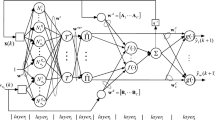Abstract
The paper presents two learning methods for nonlinear system identification. Both methods employ neural network models for representing state and output functions. The first method of learning nonlinear state space is based on using chaotic or noise signals in the training of state neural network so that the state neural network is designed to produce a sequence in a recursive way under the excitement of the system input. The second method of learning nonlinear state space has an observer neural network devoted to estimate the states as a function of the system inputs and the outputs of the output neural network. This observer neural network is trained to produce a state sequence when the output neural network is forced by the same sequence and then the state neural network is trained to produce the estimated states in a recursive way under the excitement of the system input. The developed identification methods are tested on a set of benchmark plants including a non-autonomous chaotic system, i.e. Duffing oscillator. Both proposed methods are observed much superior than well-known identification methods including nonlinear ARX, nonlinear ARMAX, Hammerstein, Wiener, Hammerstein–Wiener, Elman network, state space models with subspace and prediction error methods.







Similar content being viewed by others
References
Ljung L (1987) System identification: theory for the user. PTR Prentice Hall, Englewood Cliffs
Narendra KS, Parthasarathy K (1990) Identification and control of dynamical systems using neural networks. IEEE Trans Neural Netw 1(1):4–27
Chen S, Billings SA (1992) Neural networks for nonlinear dynamic system modelling and identification. Int J Control 56:319–346
Ljung L, Sjöberg J (1992) A system identification perspective on neural nets. IEEE Neural Netw Signal Process. 423–435
Sjöberg J, Hjalmarsson H, Ljung L (1994) Neural networks in system identification. In: Proceedings of the 10th IFAC symposium on system identification, vol. 2:49–71
Goethals I, Pelckmans K, Suykens JAK, De Moor B (2005a) Identification of MIMO Hammerstein models using least squares support vector machines. Automatica 41:1263–1272
Goethals I, Pelckmans K, Suykens JAK, De Moor B (2005b) Subspace identification of Hammerstein systems using least squares support vector machines. IEEE Trans Autom Control 50(10):1509–1519
Hong X, Chen S (2012) The system identification and control of Hammerstein system using non-uniform rational B-spline neural network and particle swarm optimization. Neurocomputing 82:216–223
Ljung L (2010) Perspectives on system identification. Annu Rev Control 34(1):1–12
Billings SA, Wei HL (2005) A new class of wavelet networks for nonlinear system identification. IEEE Trans Neural Netw 16(4):862–874
Martínez-Ramón M, Rojo-Álvarez JL, Camps-Valls G, Muñoz-Marí J, Navia-Vázquez A, Soria-Olivas E, Figueiras-Vidal AR (2006) Support vector machines for nonlinear kernel ARMA system identification. IEEE Trans Neural Netw 17(6):1617–1622
Hong X, Mitchell RJ (2007) A Hammerstein model identification algorithm using Bezier–Bernstein approximation. IET Proc Control Theory Appl 1(4):1149–1159
Elman JL (1990) Finding structure in time. Cogn Sci 14:179–211
Suykens JAK, De Moor B, Vandewalle J (1995) Nonlinear system identification using neural state space models, applicable to robust control design. Int J Control 62(1):129–152
Suykens JAK, Vandewalle J (1995) Learning a simple recurrent neural state space model to behave like Chua’s double scroll. IEEE Trans Circuits Syst Part I 42(8):499–502
Gao XZ, Gao XM, Ovaska SJ (1996) A modified Elman neural network model with application to dynamical systems identification. Proc. IEEE Syst Man Cybern Int Conf 2:1376–1381
Yu W, Poznyak AS, Li X (2001) Multilayer dynamic neural networks for nonlinear system on-line identification. Int J Control 74(18):1858–1864
Yu W (2005) State-space recurrent fuzzy neural networks for nonlinear system identification. Neural Process Lett 22:391–404
Ölmez M (2013) Exploiting chaos in system identification and control. PhD Thesis, Graduate School of Natural and Applied Sciences, Dokuz Eylül University
Cuomo KM, Oppenheim AV (1993) Circuit implementation of synchronized chaos with applications to communications. Phys Rev Lett 71(1):65–68
Chen G, Chen Y, Öğmen H (1997) Identifying chaotic systems via a Wiener-type cascade model. IEEE Control Syst Mag 8:29–36
Narendra KS (1996) Neural networks for control theory and practice. Proc IEEE 84(10):1385–1406
Author information
Authors and Affiliations
Corresponding author
Rights and permissions
About this article
Cite this article
Ölmez, M., Güzeliş, C. Exploiting Chaos in Learning System Identification for Nonlinear State Space Models. Neural Process Lett 41, 29–41 (2015). https://doi.org/10.1007/s11063-013-9332-7
Published:
Issue Date:
DOI: https://doi.org/10.1007/s11063-013-9332-7



